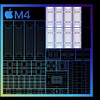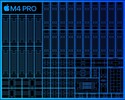Nvidia GeForce RTX 5050 Laptop vs Apple M4 8-core GPU vs Apple M4 Pro 20-Core GPU
Nvidia GeForce RTX 5050 Laptop
► remove from comparisonThe Nvidia GeForce RTX 5050 Laptop is a dedicated graphics card from the Blackwell family for laptops, which was presented by Team Green in June 2025. It uses the GB207 chip.
Like the RTX 4050 Laptop GPU, the GPU offers 2,560 unified shaders (CUDA cores) combined with a 128-bit memory bus for 8 GB GDDR7 graphics memory.
Other features of the GPU include native 5th generation ray tracing cores, PCIe 5 support, DisplayPort 2.1a and 440 TOPS AI performance (thanks to the built-in Tensor cores).
The performance without DLSS frame generation should be similar to the old RTX 4060 Laptop GPU laptop GPU. The RTX 5060 is 21 - 22% faster at 115 W (incl. Dynamic Boost) in 3DMark tests (via Videocardz). As usual, performance is heavily dependent on power consumption (TGP) and cooling. Therefore, there will also be significantly slower models in laptops.
The chip is produced at TSMC using the 4nm process (4N). The power consumption (TGP) is specified at 35-100 watts (115 watts incl. Dynamic Boost 2.0).
Apple M4 8-core GPU
► remove from comparison
The 8-core Apple M4 GPU is a graphics adapter built into the smallest Apple M4 series SoC that debuted in October 2024 alongside the new iMac. It isn't clear if this is a 10-core M4 GPU with two cores disabled, or if Apple actually makes an entirely new M4 SoC now that has fewer CPU and GPU cores by design.
A few popular video codecs can be HW-decoded and HW-encoded here but the list is nowhere near as long as what current AMD iGPUs deliver, let alone Intel iGPUs. However, there is a healthy selection of modern technologies such as ray tracing on offer.
Just like the rest of the Apple M4 chip, the graphics adapter is manufactured on a "second generation 3 nm" TSMC process that's still cutting-edge, as of late 2024. It has access to the 16 or 24 gigabytes of fast on-package LPDDR5x-7500 RAM and, apart from the iMac's internal display, allows one to connect one more monitor with an "up to 6K" resolution whereas the 10-core M4 GPU can drive 2 such monitors.
Its performance is slated to be around 15% lower than that of the 10-core M4 GPU. Still, it's going to be at least as fast as the Radeon 760M in many tasks, including gaming.
Apple M4 Pro 20-Core GPU
► remove from comparison
The Apple M4 Pro GPU (20 cores) is an integrated graphics adapter designed by Apple that's built into the 14-core Apple M4 Pro SoC. It features 20 "cores" and has access to at least 24 GB of fast 273 GB/s LPDDR5x on-package RAM depending on the configuration. As is typical for graphics adapters released in 2024, it has hardware support for ray tracing as well as mesh shading and other modern technologies. It also supports external displays with resolutions as high as "8K" and it can HW-decode a few popular video codecs such as h.264, h.265 and AV1.
Performance
Its gaming performance is at least as good as that of the GTX 1660 Ti Laptop. Please keep in mind that very few games have been compiled specifically for Apple silicon Macs meaning most titles have to be run via emulation layers. Some of them are displayed with visual artefacts as a result, or don't start at all.
- The Witcher 3 1080p Ultra = 53 fps (close to the GTX 1660 Ti Laptop)
- Baldur's Gate 3 1440p Ultra = 42 fps (close to the GeForce RTX 4050 Laptop)
- Cyberpunk 2077 2.1 Phantom Liberty 1080p Ultra = 40 fps (close to the GTX 1660 Ti Laptop)
In synthetic benchmarks, the iGPU is about 30% faster than the old M3 Pro GPU and is even on par with a fast GeForce RTX 4070 Laptop GPU (3DMark Wild Life Extreme Unlimited).
Power consumption
When under heavy CPU and GPU load, the iGPU portion of the 14-core M4 Pro consumes about 32 W according to monitoring software "powermetrics". With no load, it makes do with as little as 1 W to 3 W.
Just like the rest of the Apple M4 Pro chip, the integrated graphics adapter is manufactured on a "second generation 3 nm" TSMC process which is still cutting-edge as of late 2024.
| Nvidia GeForce RTX 5050 Laptop | Apple M4 8-core GPU | Apple M4 Pro 20-Core GPU | |||||||||||||||||||||||||||||||||||||||||||||||||||||||
| Apple M4 Series |
|
|
| ||||||||||||||||||||||||||||||||||||||||||||||||||||||
| Codename | GN22-X2 | ||||||||||||||||||||||||||||||||||||||||||||||||||||||||
| Architecture | Blackwell | ||||||||||||||||||||||||||||||||||||||||||||||||||||||||
| Pipelines | 2560 - unified | 8 - unified | 20 - unified | ||||||||||||||||||||||||||||||||||||||||||||||||||||||
| TMUs | 80 | ||||||||||||||||||||||||||||||||||||||||||||||||||||||||
| ROPs | 32 | ||||||||||||||||||||||||||||||||||||||||||||||||||||||||
| Raytracing Cores | 20 | 20 | |||||||||||||||||||||||||||||||||||||||||||||||||||||||
| Tensor / AI Cores | 80 | ||||||||||||||||||||||||||||||||||||||||||||||||||||||||
| Core Speed | 1020 - 2662 (Boost) MHz | ||||||||||||||||||||||||||||||||||||||||||||||||||||||||
| Cache | L1: 2.5 MB, L2: 32 MB | ||||||||||||||||||||||||||||||||||||||||||||||||||||||||
| Memory Speed | 14000 effective = 1750 MHz | 8533 MHz | |||||||||||||||||||||||||||||||||||||||||||||||||||||||
| Memory Bus Width | 128 Bit | ||||||||||||||||||||||||||||||||||||||||||||||||||||||||
| Memory Type | GDDR6 | LPDDR5X-7500 | LPDDR5x-8533 | ||||||||||||||||||||||||||||||||||||||||||||||||||||||
| Max. Amount of Memory | 8 GB | ||||||||||||||||||||||||||||||||||||||||||||||||||||||||
| Shared Memory | no | yes | yes | ||||||||||||||||||||||||||||||||||||||||||||||||||||||
| Memory Bandwidth | 224 GB/s | 273 GB/s | |||||||||||||||||||||||||||||||||||||||||||||||||||||||
| API | DirectX 12_2 | ||||||||||||||||||||||||||||||||||||||||||||||||||||||||
| Power Consumption | 100 Watt (35 - 100 Watt TGP) | 4 Watt | 45 Watt | ||||||||||||||||||||||||||||||||||||||||||||||||||||||
| technology | 5 nm | 3 nm | 3 nm | ||||||||||||||||||||||||||||||||||||||||||||||||||||||
| PCIe | 5 | ||||||||||||||||||||||||||||||||||||||||||||||||||||||||
| Displays | 4 Displays (max.), DisplayPort 2.1a | 3 Displays (max.) | |||||||||||||||||||||||||||||||||||||||||||||||||||||||
| Notebook Size | medium sized | ||||||||||||||||||||||||||||||||||||||||||||||||||||||||
| Date of Announcement | 02.01.2025 | 28.10.2024 | 30.10.2024 | ||||||||||||||||||||||||||||||||||||||||||||||||||||||
| Link to Manufacturer Page | www.nvidia.com | ||||||||||||||||||||||||||||||||||||||||||||||||||||||||
| Predecessor | NVIDIA GeForce RTX 4050 Laptop GPU | M3 8-Core GPU | M3 Pro 18-Core GPU |
|
| |||||||||||||||||
Benchmarks
GFXBench T-Rex HD Offscreen C24Z16 + Apple M4 8-core GPU
Average Benchmarks Apple M4 8-core GPU → 0% n=0
Average Benchmarks Apple M4 Pro 20-Core GPU → 0% n=0
* Smaller numbers mean a higher performance
1 This benchmark is not used for the average calculation
Game Benchmarks
The following benchmarks stem from our benchmarks of review laptops. The performance depends on the used graphics memory, clock rate, processor, system settings, drivers, and operating systems. So the results don't have to be representative for all laptops with this GPU. For detailed information on the benchmark results, click on the fps number.

Civilization 7
2025
Total War Pharaoh
2023
Baldur's Gate 3
2023
The Witcher 3
2015| Nvidia GeForce RTX 5050 Laptop | Apple M4 8-core GPU | Apple M4 Pro 20-Core GPU | |||||||||||||||||||
|---|---|---|---|---|---|---|---|---|---|---|---|---|---|---|---|---|---|---|---|---|---|
| low | med. | high | ultra | QHD | 4K | low | med. | high | ultra | QHD | 4K | low | med. | high | ultra | QHD | 4K | ||||
| Civilization 7 | 98 | 78.2 | 62.9 | ||||||||||||||||||
| Total War Pharaoh | 53.2 | 46.3 | 40.7 | 28.7 | 65 | 55 | 51 | 51 | 49 | ||||||||||||
| Cyberpunk 2077 2.2 Phantom Liberty | 25.9 | 20.3 | 17 | 14.3 | 50 | 48 | 45 | 40 | 25 | ||||||||||||
| Baldur's Gate 3 | 39.7 | 27.8 | 23.1 | 22.6 | 91 | 78 | 64 | 62 | 43 | ||||||||||||
| Shadow of the Tomb Raider | 103 | 39 | 34 | 30 | 181 | 110 | 100 | 87 | 57 | ||||||||||||
| Nvidia GeForce RTX 5050 Laptop | Apple M4 8-core GPU | Apple M4 Pro 20-Core GPU | |||||||||||||||||||
| low | med. | high | ultra | QHD | 4K | low | med. | high | ultra | QHD | 4K | low | med. | high | ultra | QHD | 4K | < 30 fps < 60 fps < 120 fps ≥ 120 fps | | | | | | | < 30 fps < 60 fps < 120 fps ≥ 120 fps | 1 2 2 | 2 2 1 | 2 2 1 | 3 1 | | | < 30 fps < 60 fps < 120 fps ≥ 120 fps | 1 2 1 | 2 2 | 2 2 | 2 2 | 1 3 | |
For more games that might be playable and a list of all games and graphics cards visit our Gaming List














